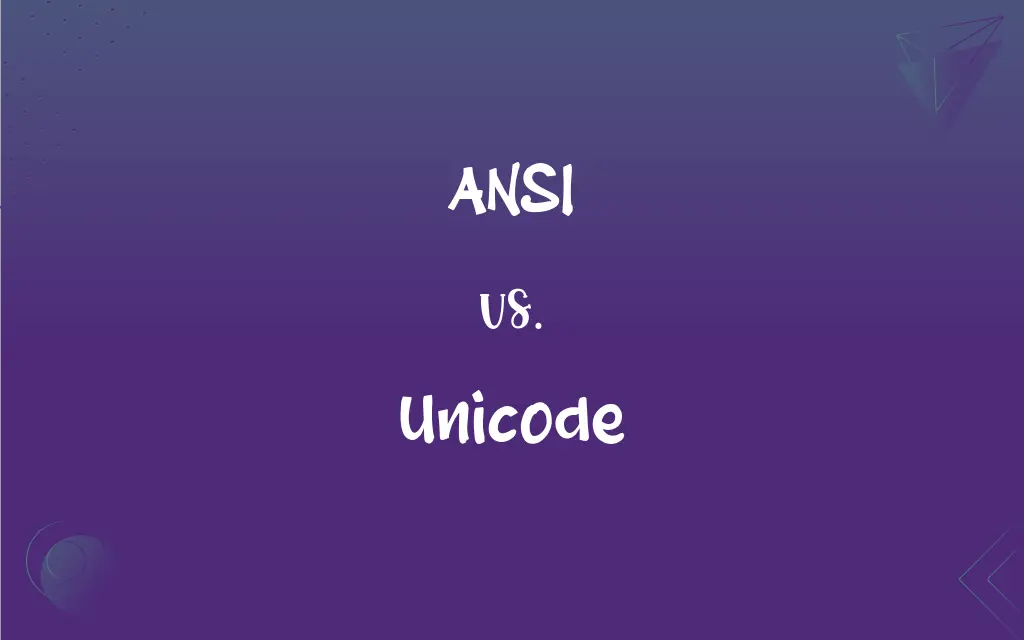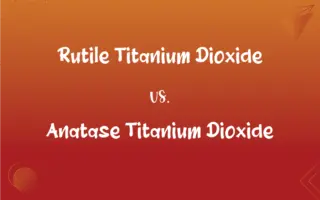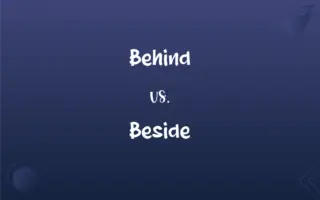ANSI vs. Unicode: What's the Difference?
Edited by Aimie Carlson || By Harlon Moss || Published on March 3, 2024
ANSI is a set of character encoding standards limited to specific languages, while Unicode is a universal encoding system supporting a wide range of characters and symbols worldwide.

Key Differences
ANSI, which stands for American National Standards Institute, represents a set of encoding standards primarily used for English and some Western languages. Unicode, in contrast, is a comprehensive character encoding standard designed to represent text and symbols from all the world’s writing systems.
ANSI encodings, like Windows-1252, are limited in scope, supporting fewer characters and are not sufficient for global language representation. Unicode, with its extensive character set including emojis and historical scripts, caters to a diverse and global user base.
ANSI is based on 8-bit encoding, which limits it to 256 characters, while Unicode uses a more flexible encoding scheme (like UTF-8, UTF-16) that can represent over a million characters. This makes Unicode more adaptable to various languages and symbols.
ANSI was predominant in the early days of computing when the focus was more on English and European languages. Unicode emerged as the need for a more inclusive and universal encoding system became apparent, especially with the advent of the internet and global communication.
In terms of compatibility, ANSI-encoded texts might face limitations or errors when used in systems outside its language scope, whereas Unicode offers seamless compatibility across different languages and platforms, ensuring consistent text representation.
ADVERTISEMENT
Comparison Chart
Full Form
American National Standards Institute encoding standards.
Universal Character Set encoding standards.
Character Support
Limited to specific languages, mainly English and Western.
Supports a wide range of characters globally.
Encoding Scheme
Primarily 8-bit, limited to 256 characters.
Variable length (UTF-8, UTF-16, etc.), over a million characters.
Global Usability
Limited, not suitable for many non-Western languages.
Highly suitable for a diverse range of languages and symbols.
Historical Context
Predominant in early computing for Western languages.
Emerged for global inclusivity in digital communication.
ADVERTISEMENT
ANSI and Unicode Definitions
ANSI
ANSI represents specific character sets used mainly for English.
My old software only supports ANSI, causing issues with non-English texts.
Unicode
Unicode uses variable-length encoding like UTF-8 and UTF-16.
Unicode's UTF-8 encoding is widely used on the web for its efficiency.
ANSI
ANSI is a precursor to more advanced encoding systems like Unicode.
Transitioning from ANSI to Unicode allowed broader language support.
Unicode
Unicode encompasses a wide range of symbols, including emojis.
Thanks to Unicode, we can use emojis in our texts across different platforms.
ANSI
ANSI refers to a set of standards for encoding characters in computers.
The text file was encoded using an ANSI standard, limiting its character range.
Unicode
Unicode is essential for global digital communication and data processing.
Unicode's extensive character set supports the diverse needs of global users.
ANSI
ANSI standards were developed by the American National Standards Institute.
ANSI was crucial in standardizing character encoding in early computing.
Unicode
Unicode provides a unique number for every character, regardless of platform.
Unicode maintains consistent character representation across different systems.
ANSI
ANSI is an 8-bit character encoding standard.
The ANSI encoding caused compatibility issues with international characters.
Unicode
Unicode is a universal character encoding standard supporting many languages.
Unicode enables the display of both English and Japanese characters seamlessly.
Unicode
A character encoding standard for computer storage and transmission of the letters, characters, and symbols of most languages and writing systems.
FAQs
Can ANSI encode Chinese characters?
No, ANSI cannot encode Chinese characters due to its limited character set.
Is Unicode compatible with all languages?
Yes, Unicode is designed to be compatible with virtually all languages and scripts.
What does ANSI stand for?
ANSI stands for American National Standards Institute.
What is Unicode primarily used for?
Unicode is used for encoding a wide range of global characters and symbols.
Why was ANSI replaced by Unicode?
ANSI was replaced by Unicode to accommodate the vast array of characters used in different languages globally.
Are ANSI and Unicode compatible?
Unicode is generally backward compatible with ANSI, but the reverse may not always be true.
Can ANSI be used for Arabic texts?
ANSI has specific versions for Arabic, but they are limited compared to Unicode's support.
Do modern operating systems support ANSI?
Most modern operating systems support ANSI, but they predominantly use Unicode.
Does Unicode support emojis?
Yes, Unicode supports a wide range of emojis.
Which is more efficient for English texts, ANSI or Unicode?
For English texts, both ANSI and Unicode are efficient, but ANSI is more compact due to its 8-bit encoding.
What is UTF-8 in Unicode?
UTF-8 is a variable-length encoding format of Unicode that is widely used for its efficiency.
What is the main limitation of ANSI?
The main limitation of ANSI is its inability to represent more than 256 characters.
Is Unicode widely used on the internet?
Yes, Unicode, particularly UTF-8, is the predominant encoding standard on the internet.
How does Unicode benefit globalization?
Unicode facilitates global communication by supporting a vast range of languages and symbols.
Is ANSI sufficient for European languages?
ANSI is generally sufficient for most European languages, though Unicode offers broader support.
Are ANSI and Unicode mutually exclusive?
No, they are not mutually exclusive; Unicode can represent all characters that ANSI can, and more.
Can Unicode handle historical and rare scripts?
Yes, Unicode can encode a wide variety of historical and rare scripts.
Is ANSI still relevant today?
While ANSI is less relevant than Unicode for global applications, it is still used in some legacy systems.
Is there a difference in file size between ANSI and Unicode texts?
Unicode text files can be larger than ANSI, especially when using UTF-16 or UTF-32 encoding.
Can Unicode support mathematical symbols?
Yes, Unicode includes a comprehensive set of mathematical symbols.
About Author
Written by
Harlon MossHarlon is a seasoned quality moderator and accomplished content writer for Difference Wiki. An alumnus of the prestigious University of California, he earned his degree in Computer Science. Leveraging his academic background, Harlon brings a meticulous and informed perspective to his work, ensuring content accuracy and excellence.
Edited by
Aimie CarlsonAimie Carlson, holding a master's degree in English literature, is a fervent English language enthusiast. She lends her writing talents to Difference Wiki, a prominent website that specializes in comparisons, offering readers insightful analyses that both captivate and inform.































































